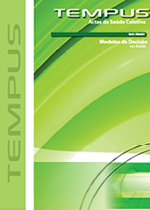Abstract
This paper presents a study of decision models in portals of games and virtual environments, and it shows a new decision model that analyzes the performance of students, considering the cognitive, affective and psychomotor domains. From the research, this study reveals that portals of games and virtual environments for health can include assessment processes, to monitor activities for health education. Understanding that the planning of these activities must be oriented by educational objectives, this work considers these objectives in the assessment process in health and presents a decision model based in the Taxonomy of Educational Objectives. This model can be considered as an alternative to performance assessment based on objective measures of performance in the portals of games and virtual environments.References
Nunes F, Machado LS, Moraes RM. Evolução da Realidade Virtual e Aumentada em Saúde: Uma Reflexão a partir de 15 Anos de SVR. Symposium on Virtual and Augmented Reality; 2014. p. 220-229.
Taekman JM, Shelley K. Virtual environments in healthcare: immersion, disruption, and flow. International Anesthesiology Clinics. 2010; 48(3):101-21.
Funge JD. Artificial Intelligence for Computer Games. Wellesley: A.K.Peters. 2004.
Machado LS, Moraes RM, Nunes FLS, Costa RME. Serious Games Baseados em Realidade Virtual para Educação Médica. Rev. Brasileira de Educação Médica (Imp.). 2011; 35:254-262.
Nogueira DN, Chaimowicz L, Prates RO. Pingo-An Online Portal for Educational Games with Customizable Content. Proceedings do XII Simpósio Brasileiro de Jogos e Entretenimento Digital. São Paulo.2013. p.80-89.
Levashenko V, Zaitseva E, Kvassay M, Kostolny J.Educational portal with Data Mining support for pupils of primary schools. Digital Technologies (DT). International Conference on. 2013. p.33-38.
C?is?ic? D, C?ic?in-S?ain M, Ogrizovic? D. mGBL-FLOSS m-learning platform. MIPRO, 2010. Proceedings of the 33rd International Convention, 2010. p.1099-1102.
Bamidis PD, Konstantinidis EI, Billis A, Frantzidis C, Tsolaki M, Hlauschek W, et al. A Web services-based exergaming platform for senior citizens: The long lasting memories project approach to e-health care. Engineering in Medicine and Biology Society, Annual International Conference of the IEEE.2011. p.2505-2509.
Wagner G. Simurena—A web portal for open educational simulation. Simulation Conference (WSC), Proceedings of the 2012 Winter. 2012. p.1-12.
Barclay AR, Bauman EB, Mihai A, Huggins E, Schaefer ER, Seider S, et al. Games & Simulation for Healthcare [Internet]. University of Wisconsin-Madison. 2013 [Citado em 2015 Março]. Disponível em: http://healthcaregames.wisc.edu/index.php.
Anderson LW, Krathwohl DR, Airasian PW, Cruikshank KA, Mayer RE, Pintrich PR, et al. (Eds..) A Taxonomy for Learning, Teaching, and Assessing: A Revision of Bloom’s Taxonomy of Educational Objectives. Allyn & Bacon. Boston, MA (Pearson Education Group). 2001.
Bastable SB, Gramet P, Jacobs K, Sopczyk DL. Health professional as educator: Principles of teaching and learning. Sudbury, MA:Jones& Bartlett. 2011.
Ferraz APCM, Belhot RV. Taxonomia de Bloom: revisão teórica e apresentação das adequações do instrumento para definição de objetivos instrucionais. Gest. Prod., São Carlos. 2010. 17(2):421-431.
Bloom BS, Engelhart MD, Furst EJ, Hill WH, Krathwohl DR. Taxionomia de Objetivos Educacionais: Domínio Cognitivo. Tradução Sant'Anna, F.M. 8. ed. Porto Alegre: Editora Globo. 1983.
Bloom BS, Krathwohl DR, Masia BB. Taxionomia dos Objetivos Educacionais: Domínio Afetivo.Tradução Cunha, J.A. 1. ed. 4ª impressão. Porto Alegre: Editora Globo. 1976.
Dave, R. Psychomotor Levels. In R. J. Armstrong (Ed.). Developing and Writing Behavioral Objectives. Tucson, AZ: Educational Innovators Press. 1970.
Reilly DE, Oermann M. Behavioral Objectives: Evaluation in Nursing. 3rd. ed. New York, NY: National League for Nursing.1990.
Conklin, J. A taxonomy for learning, teaching and assessing: a revision of Blooms’s taxonomy of educational objectives. Educational Horizons, v. 83, n. 3, p. 153-159, 2005.
Krathwohl DR. A Revision of Bloom's Taxonomy: An Overview. Theory into Practice. 2002; 41(4):212-218.
Ligeza A. Logical Foundations for Rule-based Systems. 2nd edn. Springer, Heidelberg. 2006.
Millington I, Funge J. Artificial Intelligence For Games. Morgan Kaufmann. Elsevier. 2009.
Machado LS, Zuffo MK. Development and Evaluation of a Simulator of Invasive Procedures in Pediatric Bone Marrow Transplant. Studies in Health Technology and Informatics, Amsterdam. 2003, 94:193-195.
Almeida LR, Silva ATMC, Machado LS. Caixa de Pandora: Desenvolvendo afetividade e cognição em um serious game para o enfrentamento da violência contra a mulher. In: Simpósio Brasileiro de Jogos e Entretenimento Digital - Trilha Cultura, 2013, São Paulo. Anais do XII Simpósio Brasileiro de Jogos e Entretenimento Digital, 2013. p. 23-30.
A Tempus garante critérios rigorosos, por meio de avaliação sistemática. Os autores se responsabilizam pela veracidade e ineditismo do trabalho cabendo a eles a cessão de direitos de publicação à revista. A confiabilidade dos conteúdos e a marca própria de apresentação tem como objetivo uma comunicação personalizada, adaptada aos padrões da revista, na medida em que adota critérios de excelência exigidos por seus usuários e especialistas, considerando os rigores da comunicação científica. Os autores devem especificar sua contribuição individual na concepção, delineamento, execução do trabalho, análise ou interpretação dos dados, redação e aprovação final do manuscrito. Incluir Fontes de financiamento e de apoio logístico das pesquisas. Ao final da submissão do artigo, os autores devem enviar uma declaração de cessão de direitos de publicação à Revista TEMPUS , assinada e no formato PDF (Portable Document Format ): Modelo da declaração de cessão de direitos.
